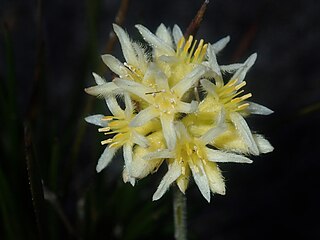
Conostylis setigera, commonly known as bristly cottonhead, is a rhizomatous, tufted perennial, grass-like plant or herb in the family Haemodoraceae and is endemic to the south-west of Western Australia.

Conostylis albescens is a rhizomatous, tufted perennial, grass-like plant or herb in the family Haemodoraceae and is endemic to inland areas of Western Australia. It is similar to Conostylis bealiana has hairy leaves and yellowish-cream to white tubular flowers.

Conostylis canteriata is a rhizomatous, tufted perennial, grass-like plant or herb in the family Haemodoraceae and is endemic to the south-west of Western Australia. It has stilted roots, flat leaves, and pale lemon-yellow tubular flowers.

Conostylis caricina is a flowering plant in the family Haemodoraceae and is endemic to the south-west of Western Australia. It is a rhizomatous, tufted perennial, grass-like plant or herb with flat leaves and heads of 6 to 8 creamy-yellow flowers.

Conostylis crassinerva is a rhizomatous, tufted perennial, grass-like plant or herb in the family Haemodoraceae and is endemic to the south-west of Western Australia. It has flat leaves and yellow tubular flowers that turn reddish as they age.

Conostylis festucacea is a rhizomatous, tufted or proliferous perennial, grass-like plant or herb in the family Haemodoraceae, and is endemic to the south-west of Western Australia. It has cylindrical or flat leaves and yellow flowers.

Conostylis hiemalis is a rhizomatous, tufted perennial, grass-like plant or herb in the family Haemodoraceae and is endemic to the south-west of Western Australia. It has flat leaves, usually with woolly grey hairs at the base, and pale yellow to cream-coloured, tubular flowers.
Conostylis latens is a rhizomatous, tufted perennial, grass-like plant or herb in the family Haemodoraceae and is endemic to the south-west of Western Australia. It has flat, green, usually hairy leaves, and greenish-yellow, tubular flowers.
Conostylis micrantha, commonly known as small-flowered conostylis, is a rhizomatous, tufted perennial, grass-like plant or herb in the family Haemodoraceae and is endemic to the south-west of Western Australia. It has leaves that are round in cross-section and have bristles or hairs on the lower edges, and pale yellowish cream, tubular flowers.
Conostylis neocymosa is a rhizomatous, tufted perennial, grass-like plant or herb in the family Haemodoraceae and is endemic to the south-west of Western Australia. It has flat, green leaves with bristles on the edges, and yellow, tubular flowers.
Conostylis pauciflora, commonly known as Dawesville conostylis, is a rhizomatous, stoloniferous, perennial, grass-like plant or herb in the family Haemodoraceae and is endemic to the south-west of Western Australia. It has flat, green leaves with bristles on the edges, and relatively few tubular flowers.

Conostylis prolifera, commonly known as mat cottonheads, is a rhizomatous, tufted, stoloniferous, perennial, grass-like plant or herb in the family Haemodoraceae and is endemic to the south-west of Western Australia. It has flat, glabrous leaves, and yellow and cream-coloured, tubular flowers.
Conostylis resinosa is a rhizomatous, tufted perennial, grass-like plant or herb in the family Haemodoraceae and is endemic to the south-west of Western Australia. It has flat, shiny leaves, yellow, tubular flowers and is similar to C. aurea.

Conostylis robusta is a rhizomatous, tufted, stoloniferous, perennial, grass-like plant or herb in the family Haemodoraceae and is endemic to the south-west of Western Australia. It has flat, green leaves with bristles on the edges, and heads of yellow flowers on a relatively long flowering stem.

Conostylis seminuda is a rhizomatous, tufted perennial, grass-like plant or herb in the family Haemodoraceae and is endemic to a small area in the south-west of Western Australia. It has flat leaves and golden yellow, tubular flowers.

Conostylis seorsiflora is a rhizomatous, tufted perennial, grass-like plant or herb in the family Haemodoraceae and is endemic to the south of Western Australia. It has flat leaves and yellow, tubular flowers.

Conostylis stylidioides is a rhizomatous, stoloniferous, perennial, grass-like plant or herb in the family Haemodoraceae and is endemic to the west of Western Australia. It has flat leaves and yellow, tube-shaped flowers.

Conostylis teretifolia is a rhizomatous, tufted, perennial, grass-like plant or herb in the family Haemodoraceae and is endemic to the south-west of Western Australia. It has flat leaves, short stems and yellow to reddish, tube-shaped flowers.

Conostylis teretiuscula is a rhizomatous, tufted perennial, grass-like plant or herb in the family Haemodoraceae and is endemic to the south west of Western Australia. It has flat leaves and yellow, tube-shaped flowers.
Conostylis tomentosa is a rhizomatous, tufted perennial, grass-like plant or herb in the family Haemodoraceae and is endemic to the south-west of Western Australia. It has flat leaves with bristles of hairs on the leaf margins, and golden yellow, tubular flowers.















